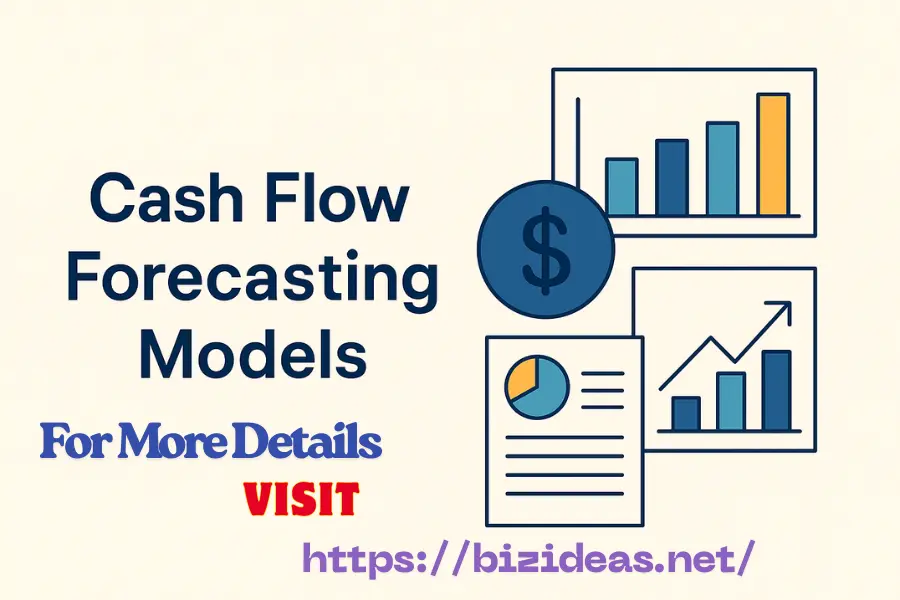Top Cash Flow Forecasting Models for Smarter Financial Planning
Updated: 28 Sep 2025
Mastering Cash Flow Forecasting Models
Cash is the heartbeat of any business, and knowing how much you’ll have tomorrow can be the difference between growth and collapse. That’s where cash flow forecasting models come in. These financial tools help predict future cash movements so you can make smarter decisions, avoid shortfalls, and seize new opportunities without second-guessing. Whether you’re a startup founder, small business owner, or finance manager, understanding the right forecasting model can transform how you plan for the future. In this guide, we’ll break down the best models, how to build them, and the tools that make forecasting easier than ever.

What Is Cash Flow Forecasting?
Cash flow forecasting is the process of estimating how much cash a business will receive and spend over a given period—usually weekly, monthly, or quarterly. It provides a forward-looking view of your finances and helps answer a critical question: Will we have sufficient cash to cover our expenses?
At its core, cash flow forecasting isn’t just about crunching numbers—it’s about making sure your business stays healthy and prepared. Whether you’re planning for expansion, managing debt, or navigating a slow season, forecasting helps you make confident decisions backed by real data.
There are two main types of forecasts:
- Short-Term Forecasts: Typically cover 1–13 weeks. These are ideal for managing immediate cash needs like payroll, rent, and supplier payments.
- Long-Term Forecasts: Can span several months to a few years. These are used for strategic planning, investment decisions, or fundraising.
With the right model, you can anticipate cash shortages, avoid last-minute borrowing, and align your financial decisions with business goals.
Benefits of Cash Flow Forecasting Models
Using cash flow forecasting models gives business owners and finance teams a powerful edge. Instead of reacting to financial surprises, you gain the foresight to steer your business with confidence. Here are the key benefits:
1. Better Financial Planning
Forecasting helps you map out upcoming cash needs, making it easier to budget for expenses like inventory, salaries, taxes, or marketing campaigns.
2. Avoid Cash Shortages
A well-maintained forecast alerts you when cash is running low—before it becomes a crisis. This gives you time to adjust spending, secure financing, or negotiate payment terms.
3. Informed Decision-Making
From hiring new employees to launching new products, accurate forecasting allows you to base decisions on facts, not guesswork.
4. Supports Business Growth
By predicting surplus cash, you can confidently reinvest in your business—whether it’s opening a new location or investing in new equipment.
5. Improves Stakeholder Confidence
Lenders, investors, and partners love numbers. A clear forecast builds credibility, showing that you’re financially responsible and forward-thinking.
6. Stress Reduction
Perhaps the most underrated benefit—clarity over cash flow reduces anxiety. You’re no longer flying blind, and that peace of mind is invaluable.
Types of Cash Flow Forecasting Models
Not all businesses are the same—and neither are cash flow forecasts. Choosing the right model depends on your company’s size, financial complexity, and the purpose of the forecast. Here are the most commonly used cash flow forecasting models:
1. Direct Cash Flow Forecasting Model
This model uses actual cash inflows and outflows (e.g., customer payments, supplier bills, salaries) to forecast short-term cash positions—usually over 1 to 13 weeks.
Best for:
Small businesses
Daily/weekly cash planning
Short-term decision-making
Pros:
✔ High accuracy for short periods
✔ Clear view of immediate liquidity
Cons:
✘ Requires detailed transaction data
✘ Time-consuming if done manually
2. Indirect Cash Flow Forecasting Model
This model starts with projected net income (from the income statement), then adjusts for non-cash items (like depreciation) and changes in working capital to predict cash position.
Best for:
Medium to large businesses
Long-term financial planning
Strategic forecasting
Pros:
✔ Links forecasting to the overall business strategy
✔ Useful for scenario planning
Cons:
✘ Less precise in the short term
✘ Requires strong accounting knowledge
3. Short-Term vs. Long-Term Models
- Short-Term (1–13 weeks): Helps with operational cash needs, such as payroll, inventory, and paying suppliers.
- Long-Term (3–12 months or more): Supports budgeting, fundraising, and capital investments.
4. Rolling Forecast Model
A dynamic forecast that updates regularly (weekly or monthly), always projecting forward over a fixed window (e.g., 3 months ahead).
Best for:
Rapidly changing businesses
Growing startups
Businesses with seasonal variation
Choosing the Right Model:
Use direct forecasting for day-to-day cash management, and indirect forecasting for strategic, long-term financial planning. Many businesses use a combination of both to get the full picture.
Popular Cash Flow Forecasting Templates & Tools
Building a cash flow forecast doesn’t mean starting from scratch. Today, a wide range of tools, both simple and advanced, can help you build effective cash flow forecasting models quickly and accurately.
1. Excel and Google Sheets Templates
Spreadsheets are the most popular starting point, especially for small businesses and startups.
Why they’re useful:
- Customizable to your specific needs
- Easy to use with basic formulas
- Cost-effective (often free)
Popular Templates:
- Microsoft Office cash flow forecast template
- Google Sheets cash flow planner
- SCORE or Vertex42 cash flow templates
2. Accounting Software with Built-in Forecasting
Many cloud-based platforms now include forecasting features to help you plan better.
Top options:
- QuickBooks Online – Great for small businesses
- Xero – Includes real-time cash flow tracking
- FreshBooks – Ideal for freelancers and service providers
3. Dedicated Forecasting Software
For growing businesses with more complex needs, specialized forecasting tools provide advanced capabilities.
Best-in-class tools:
- Float – Integrates with QuickBooks & Xero; user-friendly dashboard
- Fathom – Visual reports and KPIs for finance teams
- PlanGuru – Powerful scenario planning and analytics
- Dry run – Great for cash flow modeling and collaboration
4. ERP Systems
Larger enterprises often use ERP platforms like NetSuite, SAP, or Oracle, which offer robust forecasting and financial planning tools—though they come at a higher cost and complexity.
5. AI-Powered Tools (Emerging Trend)
AI-based forecasting software like CashAnalytics or Jirav uses predictive analytics to forecast more accurately using historical trends, sales projections, and real-time data.
Tip:
Start with spreadsheets if you’re new, then upgrade to automated tools as your business grows or your needs become more sophisticated.
Step-by-Step: How to Create a Cash Flow Forecasting Model
Creating a cash flow forecasting model might seem complex, but breaking it into simple steps makes it manageable even if you’re not a financial expert. Here’s how to build one from scratch:
Step 1: Set the Forecasting Period
Decide how far ahead you want to plan:
- Short-term (1–13 weeks) for daily operations
- Long-term (3–12 months) for strategic planning
Choose based on your business needs, industry, and financial stability.
Step 2: Estimate Cash Inflows
List all expected sources of income:
- Customer payments (invoices, subscriptions)
- Loan proceeds or investor funding
- Tax refunds or grants
- Other income (interest, asset sales)
Use historical data and current sales trends to project accurately.
Step 3: Estimate Cash Outflows
Include all regular and one-time expenses:
- Rent and utilities
- Payroll and benefits
- Inventory or supplies
- Loan repayments
- Marketing and software subscriptions
- Taxes and fees
Don’t forget small, recurring costs—they add up quickly.
Step 4: Calculate Net Cash Flow
Use the formula:
Net Cash Flow = Total Inflows − Total Outflows
Do this for each period (weekly or monthly) in your forecast.
Step 5: Determine Opening and Closing Balances
Calculate the cash balance for each period:
Closing Balance = Opening Balance + Net Cash Flow
The closing balance of one period becomes the opening balance for the next.
Step 6: Review and Analyze the Forecast
Look for:
- Periods of cash shortage
- Surplus cash, you can reinvest
- Unusual patterns or spikes
Adjust your plans accordingly.
Step 7: Update Regularly
A forecast is not a one-time task. Update it weekly or monthly based on actual performance and changing circumstances.
Best Practices for Accurate Cash Flow Forecasting
Even the best cash flow forecasting models can fall short if not handled with care. These best practices ensure your forecasts remain reliable, realistic, and ready to support sound business decisions.
1. Use Historical Data as a Baseline
Start by reviewing past cash flow statements. Patterns in previous sales, expenses, and seasonality will give you a solid foundation to predict the future.
2. Be Realistic — Not Overly Optimistic
Avoid overestimating income or underestimating expenses. Base your projections on conservative figures, and prepare for unexpected dips in revenue or sudden expenses.
3. Break Forecasts into Short Periods
Weekly or biweekly forecasting gives you better control over your cash position, especially during volatile periods. You’ll spot issues before they snowball.
4. Factor in Seasonal Variations
Plan for slow and busy periods. For example, retail businesses often see a spike in cash flow during the holidays and a dip in the early months of the year.
5. Include Best, Worst, and Realistic Case Scenarios
Scenario planning allows you to model how changes in sales, pricing, or costs will affect your cash flow. It helps in making proactive, not reactive, decisions.
6. Track and Compare Forecast vs. Actual
Regularly compare your forecast with actual cash flow. This helps you refine your model and become more accurate over time.
7. Update Regularly — Not Just Once a Year
Forecasts should be living documents. Update them monthly (or weekly, if possible) to reflect changes in your business environment or goals.
8. Automate Where Possible
Use software or templates that sync with your accounting system. Automation reduces manual errors and saves time, especially as your business grows.
Common Mistakes to Avoid in Cash Flow Forecasting
Even experienced business owners can make forecasting errors that lead to cash flow issues. Avoiding these common mistakes will help you build accurate and reliable cash flow forecasting models.
1. Overestimating Revenue
It’s easy to be optimistic, but forecasting based on best-case sales scenarios can lead to cash shortages. Always use conservative estimates based on actual trends, not hopes.
2. Ignoring Irregular or Hidden Costs
Forgetting small recurring expenses—like subscriptions, software, or bank fees—can throw off your forecast. Also, account for one-time costs like equipment repairs or legal fees.
3. Not Updating the Forecast Regularly
A forecast is only useful if it reflects current data. Outdated projections won’t help you make informed decisions. Set a schedule to review and update your forecast (weekly or monthly).
4. Not Considering Payment Delays
Assuming customers always pay on time is risky. Include realistic payment timelines and factor in delays, especially if you’re offering net 30 or net 60 terms.
5. Using One-Size-Fits-All Models
Every business is different. A retail business and a consulting agency will have completely different cash flow patterns. Customize your model to match your specific business type and goals.
6. Failing to Include Taxes and Seasonal Expenses
Many forget to factor in quarterly tax payments or seasonal spikes in expenses. These can dramatically affect your cash position if not forecasted properly.
7. Relying Solely on Software Without Understanding the Data
While tools can automate forecasting, understanding your numbers is key. Blind reliance on software can lead to wrong assumptions and poor decisions.
Case Study: Cash Flow Forecasting Model for a Small Business
Let’s walk through a simplified example of a cash flow forecasting model for a small e-commerce business named “GlowCraft Skincare”. This will help you see how the process works in real life.
Business Profile:
- Industry: Skincare e-commerce
- Monthly revenue: ~$10,000
- Key expenses: Inventory, advertising, salaries, software subscriptions
- Forecasting period: 3 months (Short-Term, Direct Method)
Cash Flow Forecast (3-Month Sample)
| Month | Opening Balance | Cash Inflows | Cash Outflows | Net Cash Flow | Closing Balance |
| July | $5,000 | $10,000 | $9,500 | $500 | $5,500 |
| August | $5,500 | $9,500 | $10,200 | -$700 | $4,800 |
| September | $4,800 | $11,000 | $9,000 | $2,000 | $6,800 |
What This Forecast Shows:
- In August, GlowCraft experiences a dip due to increased inventory costs.
- In September, revenue rebounds with the launch of a new product.
- This forecast helps the owner:
- Delay large purchases in August
- Focus on marketing in September when cash is healthier
- Avoid cash crunch surprises
- Delay large purchases in August
Key Takeaway:
Even a simple monthly cash flow forecast provides clear visibility and allows better decision-making. As your business grows, you can scale this model to weekly tracking or integrate software to handle more complex data.
Conclusion
Plan Smarter with the Right Cash Flow Forecasting Models
In business, cash is king—and cash flow forecasting is your crown. Whether you’re a solo entrepreneur or managing a growing company, using the right cash flow forecasting model empowers you to plan, adapt, and thrive with confidence.
From basic spreadsheets to advanced AI tools, there’s a model for every business size and stage. When done right, forecasting isn’t just about predicting numbers—it’s about building stability, reducing stress, and seizing opportunities without hesitation.
Take Action Today:
- Choose a model (start with Excel or explore tools like Float or QuickBooks)
- Build your forecast (even a 3-month plan can reveal a lot)
- Update regularly and adapt as your business grows
Need help creating a custom cash flow model or choosing the right tool? Start with a free template—or explore forecasting apps that sync with your business systems.
- For bold: [b]text[/b]
- For italic: [i]text[/i]
- For underline: [u]text[/u]





